














We are officially at the start of the ‘silly season’ - serious matters are put on the back burner and thoughts turn to what will be happening over the festive sea son – who’s coming to stay, who’s not, where we should we go to for a holiday, and how much money we can afford to spend on gifts, turkey and the wine…
Fortunately for all of us living here in Stan ford, we can relax and unwind over the festive season, but let’s spare a thought for people in other areas who can’t, who must watch their back every second of the day.
However, having said that, even in a small community like ours there are issues that don’t go away even during the festive season. Bea Whittaker is the driver of one such ini tiative – how do we keep Stanford the happy and energised little gem we’ve come to enjoy, when things work and where problems, where
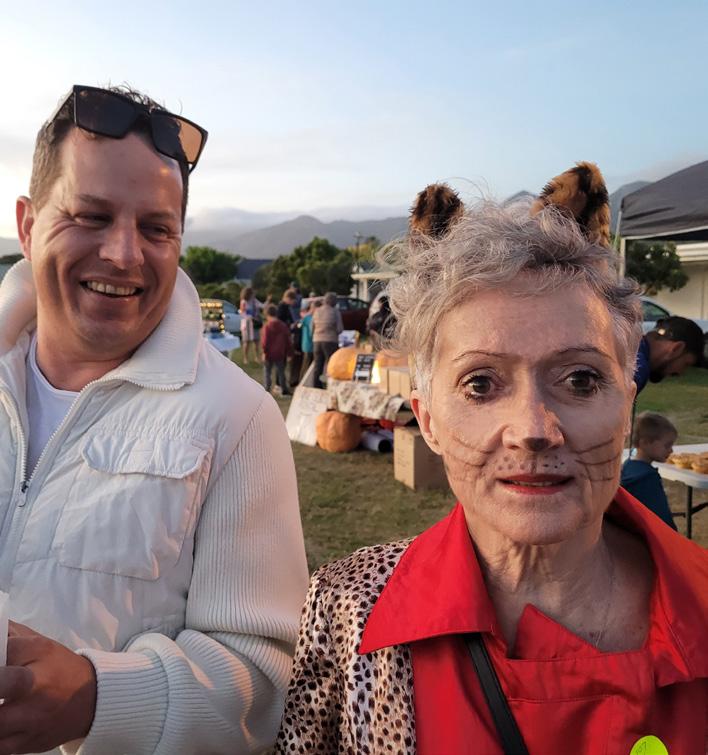
possible, are sorted? See her take on page 3. And speaking of energy, it’s heart-warming to see how passion, care and vibrancy is such a big part of what Stanford is today, whether it be in new foodie journeys (see page 13), deal ing with prickly issues like our Leiwater (I’m still trying to understand whether there is a problem on this front or not), or negotiating a better solution for the Paradise Park residents who, we now understand, have been accom modated elsewhere.
I hope you find plenty to spark your interest in this, the first of the two November editions – and hey, don’t forget the festive season is just around the corner.
Happy reading!
Circles of fire, witches, broomsticks, pump kins, and a whole lot of trick-or-treat fun - that was the buzz at the Halloween event at last Friday’s Sunset Market on the Stanford Village Green. Crazy costumes, plenty of green and purple face paint, young and not so young all getting into the swing of things – just as they always do in Stanford!



LIZ CLARKE
Publishing Editor Articles | Photography | Reporting 060 627 9644
liz@stanfordnewsagency.co.za
MELISSA MC ALPINE
Communications Director Advertising | Marketing | Social Media 078 324 5692
melissa@stanfordnewsagency.co.za
www.stanfordnewsagency.co.za


LizThe Stanford Spectator is proudly brought to you by the Stanford News Agency
Disclaimer: Great care has been taken in the preparation of this publication. However, Stanford News Agency cannot accept responsibility for any errors which may inadvertently have occurred. The opinions expressed herein are those of the authors and/or persons interviewed, and do not necessarily reflect the views and values of Stanford News Agency. Any comments, suggestions or complaints may be forwarded to liz@stanfordnewsagency.co.za or melissa@stanfordnewsagency.co.za.
Stanford Spectator
is a thriving village community –an investment gem. It’s a place that more and more big city dwellers are calling home. Well run, no litter, a pristine environ ment, a rich and protected heritage – could you want for anything more?
Stanford
“Yes, you certainly could” says Bea Whittak er, a community front runner and accom plished singer who knows and loves ‘this little piece of paradise’ like the back of her hand and is not afraid to speak out about things that she holds dear.
“First and foremost, we need younger members of our growing community to step up to the plate and pick up where the older generation, many of them long past retire ment age, are wanting to let go.”
The simple truth, she says, is that people, new families, or whoever would like to invest in a small village like Stanford have a respon sibility to ensure that the structures and organisational networks built up over many years, are properly maintained. It makes sense, she says.
“Nobody wants to see their investment going down the drain. If you don’t have willing hands to take on the work needed, that is the risk.”
Bea and husband Basil moved to Stanford more than 25 years ago as they wanted to start a new life in the country, far away from the crowds.
At that point Bea was too young to retire, so she started her own consultancy business working from home ‘like everyone does these days’ only closing her business last year when she decided to retire!
“It taught me a good lesson that one can work and still be involved in the community.
Basil on the other hand retired at 50 and did all Bea’s admin and finances.
“Just as well,” says Bea. “Or I would not have had time for community work!”
Like a child, the village needed nurturing, she explains. “We needed proper structures in place where there weren’t any, which meant that those who could had to volunteer to take on various tasks, and boy oh boy did we work!”
Stanford’s 50s stalwarts, like Mariana and Pieter Esterhuizen, Martin and Annie Ranger, Judi and Keith Brown and so many others –too many to name – ploughed all their efforts into making the village a success, Bea points out.
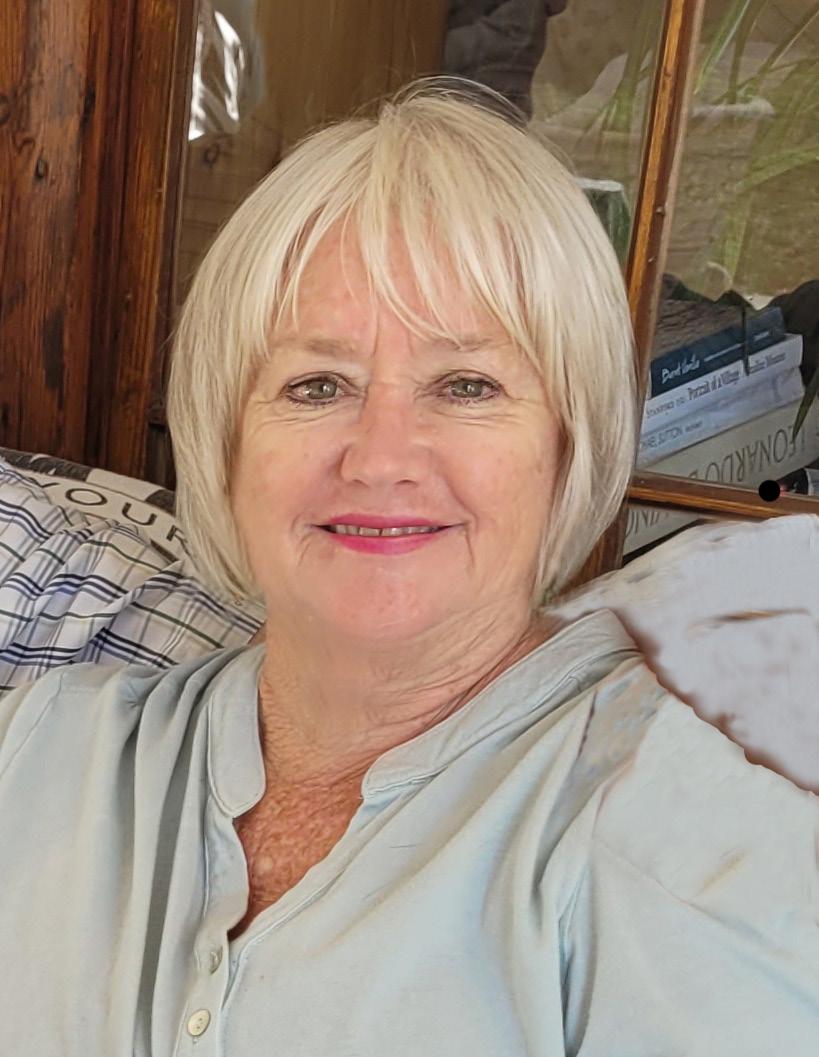
“They mustn’t be forgotten. What we see today is the result of those early efforts, a caring and well-run community – so, naturally like good parents we want to see our ‘child’ flourish in the hands of the next generation.”
“The big need now is for people to act as chair for meetings. It doesn’t require much input or much time, it is more the presence of a chair and the proper meeting structure that counts.”
Just as it is time for the next generation of Stanford to grab the baton and run with it, another call is for retirees looking to keep themselves busy, to also get involved.
A
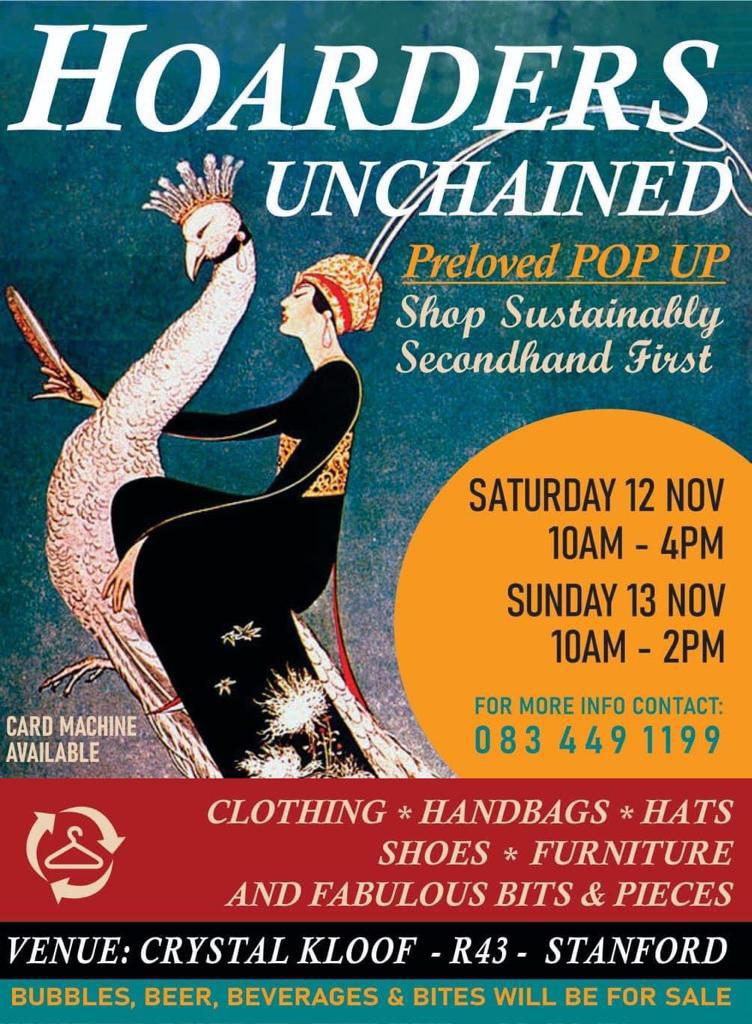
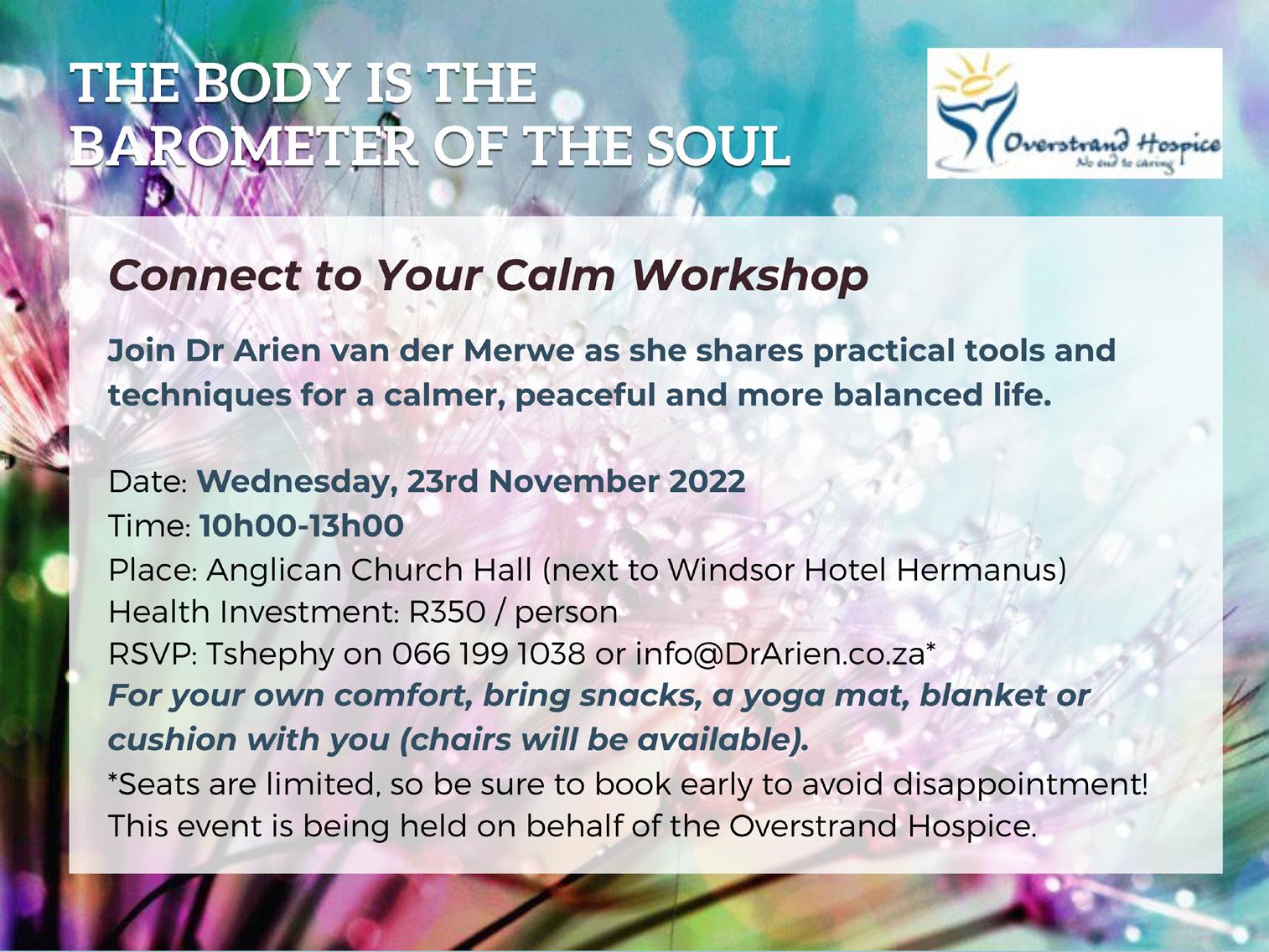

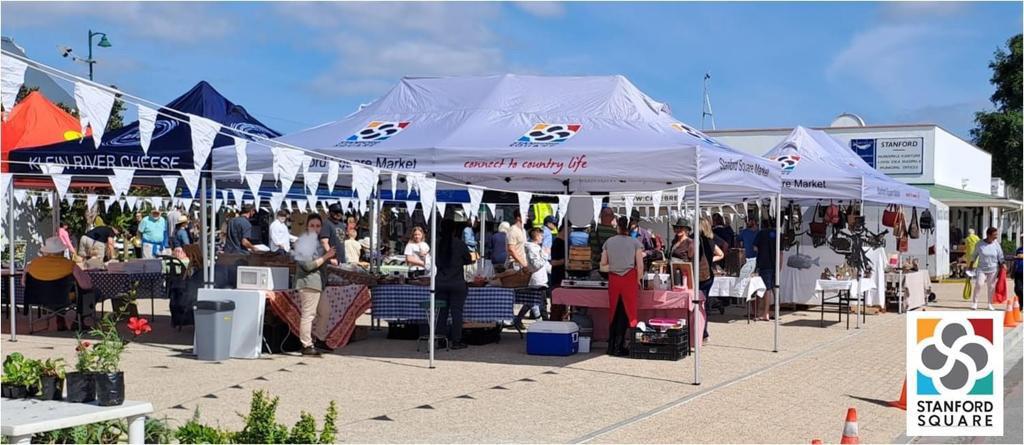

You get the feeling that the Stanford Musical Fellowship that began with baby steps a few months ago has taken wings with more and more of Stanford's local talent coming to the fore. That was certain ly the case at Searles' on the last Sunday in October when new faces and voices made their debut. One such newbie was Leozanne Bezuidenhout who had never performed on stage before.
"You see, the only time I ever sing is in the shower. My neighbour once heard my singing and told me I had a great voice and that I should consider singing in public."
So, with Andrew Herriot's' tuition and a little bit of Dutch courage, Leozanne decided to make a go of it, singing two of her favourite songsSacrifice and Summertime.
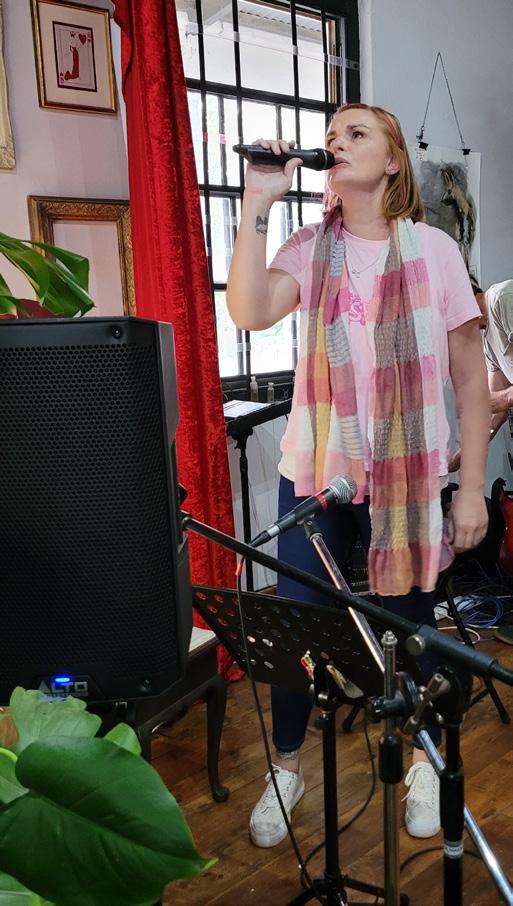
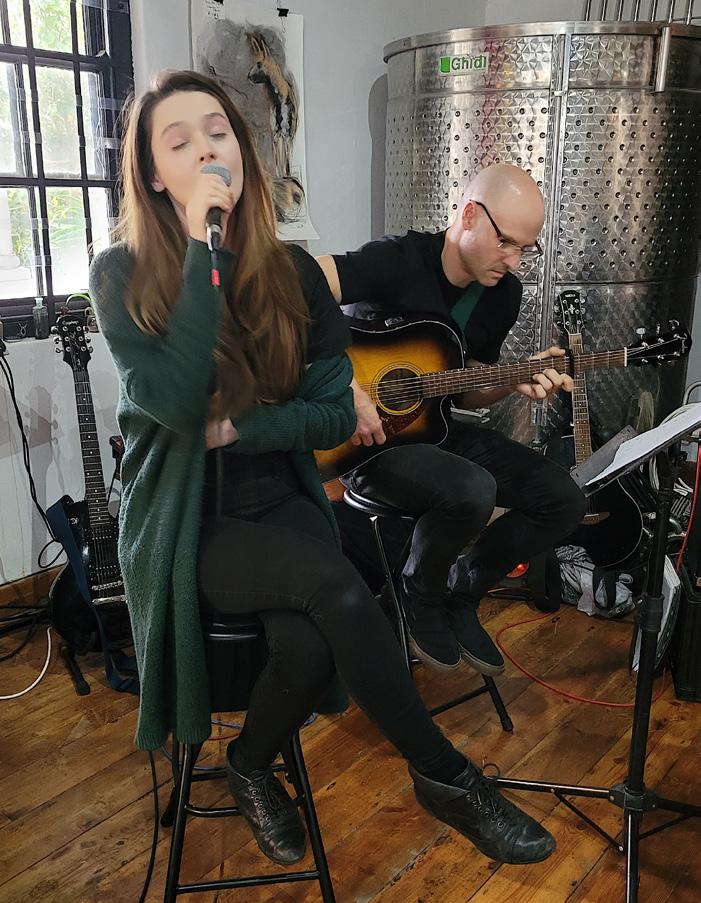

Other great performers on the day included the Anderson Twins, Catherine Francis, Terry Maritz (Rori), and the kids from the Butterfly Centre, to name just a few.


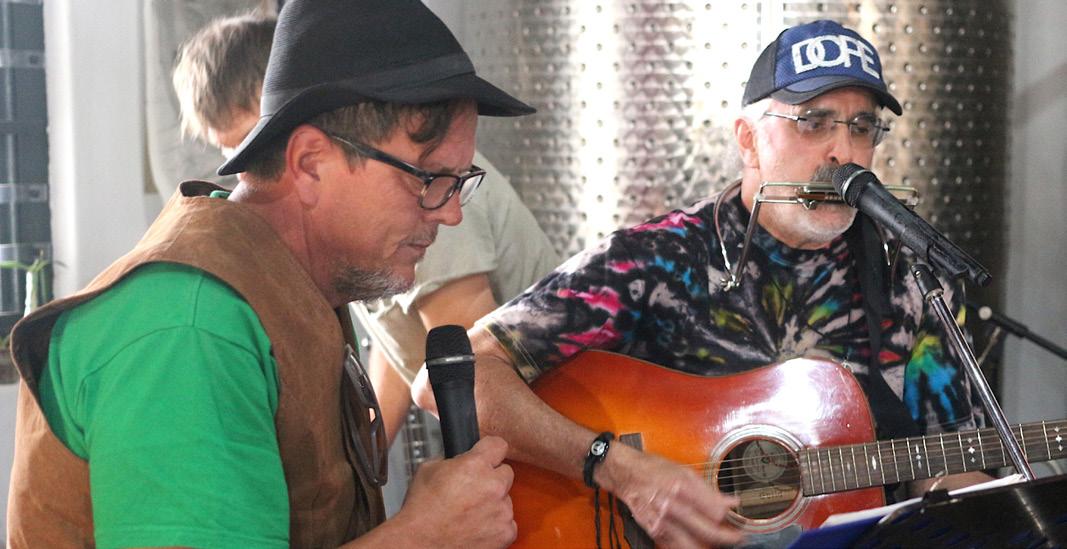
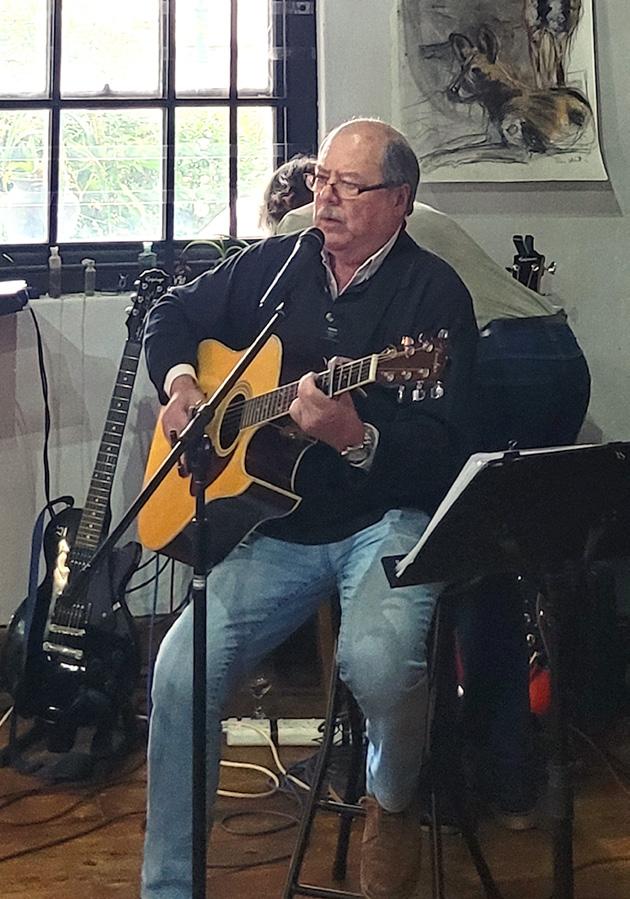
committee member of Stanford Association of Tourism, Martin Ranger, brought a touch of nostalgia to the formalities of the Association’s AGM at the end of last month, recalling the early days when the Stanford Valley had very little in the way of a strategy and working vision to secure its scenic beauty and historical importance as a heritage village.
“When we first came to check out the village on a wet August Sunday almost 20 years ago,” Ranger said, “Queen Victoria Street was empty, there was nothing open, just the bar in Stanford House (later Hennies Steakhouse). Food? “No. But we can defrost some butternut soup?” So, we decided against Stanford.”
A year later, Ranger recalled “when we saw an article about Stanford in Country Life we decided to try again. What we didn’t realise then was that we were part of a mass of baby-boomer retirees moving in, led by Bea and Basil Whittaker.”
What they became, he said, was a young-at-heart, energetic group with a variety of useful skills.
“What we have now, is because of the vision and determination we all had to go the extra mile and establish conservation, heritage, and tourism strategies for the future.
Our branding began with ‘A Village Green’, progressed to ‘A taste of village life’ and is now ‘Connect to country life’. In 2012, we were voted the best village in South Africa, so that says a lot.”
Martin said that the loss of funding from the Overstrand Municipal ity remained an ongoing issue that hopefully would soon be resolved. Even so, he said, Stanford had still maintained its place in the tourism, hospitality and accommodation markets. The recent Stanford Culinary celebration, under the umbrella of UNESCO, was a landmark event that had brought a lot of enthusiasm, positive publicity and feedback.
It was suggested that the event could be an annual one to establish Stanford as a go-to place on the culinary map, and that the Association should make this their flagship initiative.

The Association shall continue to have its headquarters at the Stanford Visitor Information Centre, courtesy of the Cape Whale Coast Tourism – formerly known as the Tourism Office.

• The Stanford Association of Tourism and Business is a public, non-profit organisation promoting tourism and commerce for the benefit of its members and develops tourism and businesses oppor tunities for all urban and rural residents within the greater Stanford municipal area.

Included in its brief is:
• Communicating the attractions of Stanford and the surrounding areas,
including its scenic beauty, climate, places of interest and industry through advertising, press releases, illustrated material, videos, social media or any other medium.
• Promoting and assisting in the organization or management of exhibi tions, festivals, displays, sports meetings, entertainment, tours, visits and attractions in Stanford and environs.
up a large family home in Johan nesburg with all its familiar furniture and bits and pieces was something that new Stanfordians, Lynda Trotter and her husband Ian, weren’t looking forward to.

“It was like we were saying goodbye to the treasures and memories that were part of our, and our family’s’ lives” she says. “It takes so many years to build up a legacy and just a few days to dismantle it. But when you are doing serious downsizing and moving to an other province, what options do you have?”
With thoughts of auctions, second hand furniture shops, advertising on Gumtree as all part of the mix, Lynda says she got more and more sad.
“Then one day, when I was packing away some beautiful family linen and wondering what I should do with it all, I thought – no – I’m not letting any of this go, we’ll take the whole lot with us.”
She admits that she had no idea what she was going to do with a house full of furniture she no longer needed, not to mention having to pay the cost of storage.
“I think one thing that Covid has taught us is to forget the conventional way of doing business and to think differently, which is exactly what we did.”
Within a few months of moving to her new Stanford home, Lynda had found a small premises in Queen Victoria Street, which she then used as a setting for her new venture – a pre-loved family home pop-up shop.


“In the beginning I was terrified never having done anything like this before. What would people think when I told them I was selling my family furniture?”
But to her surprise, people were interested.
“It’s lovely to see their faces when I tell them about the history and the background of each of the pieces. And what is so nice is that when they buy something, there’s always the promise that they will care for it and cherish it, just as we have done. I couldn’t ask for anything more.”
“Of course, there will come a time when we have no more left to sell. But I will be happy that everything has gone to local homes. It’s also been such fun getting to know the people in our Village and hearing their stories. I’ve learned a lot of new skills and this experience has also taught us that all things are possible.”


Weall agree that early learning and preparing children for school is all important. But what is a parent to do when they have no income and are unable to afford sending their children to pre-school? This is where Stanford’s Family in Focus (FiF) programme comes in.
The FiF programme was started by Jenny October-Mars 12 years ago under the umbrella of the Western Cape Foundation for Community Work (FCW), who provide training for Practitioners in Early Childhood Development to carry out their work in the childrens’ homes. The beauty of this programme is that it not only teaches a child the basics for Grade R – it also teaches parents how to teach their children the ba sics without having to spend money. For example, they can use clothes pegs to learn their colours, and potatoes, for example, to learn how to count. All sorts of household items can be used – cereal boxes, milk cartons, egg boxes, toilet roll inners, to name just a few.
For children who are preparing to enter Grade R, there are work books with various themes such as Nature, My Body, The Clothes I Wear, Careers, Transport, etc. The curriculum is constantly evolving, giving these young minds the confidence to start school without having first attended a formal pre-school.
Stanford Rotary have supported this initiative for the past 10 years and we have seen, firsthand, the growth that has happened during that time. We provide team members with backpacks and a set of statio nery at the beginning of each year, and top that up mid-year. Once a month, parent workshops are held in a group setting where Rotary also provides some light refreshments.
And the cherry on top - after 12 years, the programme has been awarded with a certificate naming it the Best Performing FiF Project in the Overberg! We’re extremely proud of Jenny and her teams across Stanford, Gansbaai, Mount Pleasant and Zwelihle.
As always, we rely on the generosity of the community to make all of this possible. Should you wish to get involved, please feel free to get in touch with us.

the newly elected and appointed members of the Stanford Community Police Forum. A team representative from our diverse and beautiful community, and a team whose job it is to work closely with our police force and members of the public to create a safer and more thriving environment for every single one of us. Our mandate is very clear: ‘Working for you and with you to make Stanford a place we can all be proud of.’
Whatdo Béarnaise, Bocuse and Baguette have in common? Yes, they all have something to do with French nouvelle cuisine. They are also the names of three donkeys that have captured the hearts of many in and around Stanford.
White Water Farm is the country estate out side Stanford on the road to Caledon. It has al ways been the getaway choice for its farm-style country food and mountain walks, but more lately as an international destination for a bed and breakfast basket experience, where peace, quiet and unspoilt scenery are the norm.
Except, that is, for the baboons!
And that’s where dad, Bocuse, mum Béar naise, and daughter Baguette come into the
picture. Their job is to police the marauders and protect the vegetable gardens from being stripped.
“Donkeys are extremely intelligent animals” says their “keeper” and estate administrator Cameron Inggs. “They know what their job is, and they know that if they do it well, they get extra carrot treats.”
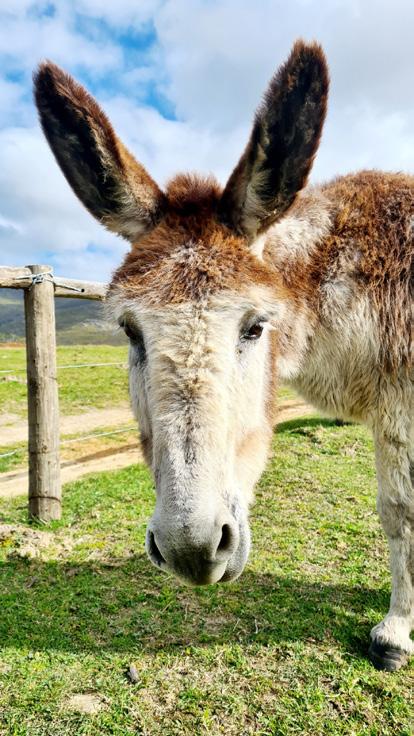

The donkeys, all rescues, were originally adopted by a farmer in Stanford, and then ‘inherited’ by Cameron and his family who took ownership of White Water Farm two years ago.

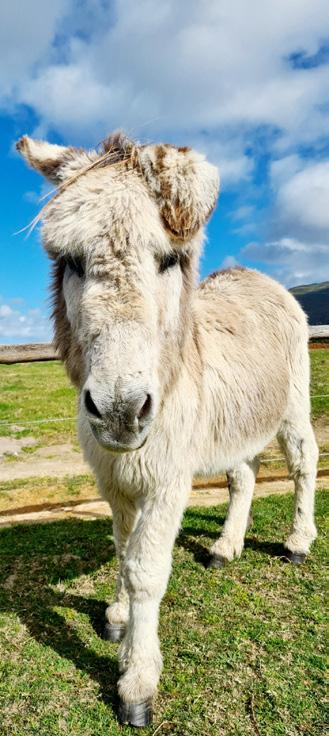
“Having them around during the tough Covid years was a blessing. They are more than farm animals; they are our friends. They love been cuddled and petted. It is all about trust and respect.”
Cameron admits that working in the farming
and the hospitality industry has meant “think ing about things very differently.”
The overseas guests are coming back –“that’s for sure” – but they want a different sort of experience, a lot simpler and more down-sized.
“That’s why we now concentrate on the food baskets which we deliver to our self-catering guests, depending on their tastes and needs.”

While he chats about the farm’s new initia tive, Béarnaise, Bocuse and Baguette stand close by.
“They are guarding me right now,” he says with a smile. “Look, we must accept they’re getting older, plus a bit lazy, and to be honest they are not as good at policing as they were. Maybe we should up their wages or get more carrots! Whichever way, we love them – and always will!”
or traction remains to be seen. But let’s hope it gets mooted for starters.
I asked ratepayers’ chairman, Louis Roodt, what he thought of the idea. He said that he believes there would be certain traffic challenges but proposed that the suggestion be put forward as a pilot project.
The new Stanford Square Market is bringing the heart and soul back to the village in a really good way. By walking through and browsing around the various stalls one soon gets a sense that the new market is a welcome addition to the Satur day vibe in Stanford.
A small incident, however, made me won der whether we should take the next step and close a short portion of Queen Victoria Street – only for the duration of the market that is – allowing market goers a greater
freedom of movement and more trading space.
The incident I am referring to involved a small toddler who wandered away from mum and walked into the road thinking it was part of the market’s safe space. Fortunately, no harm came to him, as he was pulled back to safety very quickly. But it might have been different if a vehicle was using the road at the same time. Whether the suggestion of a short-period road clo sure on market mornings gets any support
Just by way of background, the reclaiming of city streets became global movement during the Covid pandemic when indoor dining was banned and outdoor dining be coming the norm. And it seems people liked it. They enjoyed the fresh air, the absence of car noise and the freedom to move around as they pleased. In many places, those streets have remained pedestrian-only precincts.

Can a municipality like the Overstrand take on a street reclamation initiative? We’ll have to wait and see.


Our menu has been updated and has some thing to cater for every taste. The extensive breakfast menu includes some exceptional items, like our Rosti Royale, for instance, which has become a firm favourite. It’s a potato rosti topped with smoked salmon, a poached egg, capers, all topped off with basil crème fraiche.
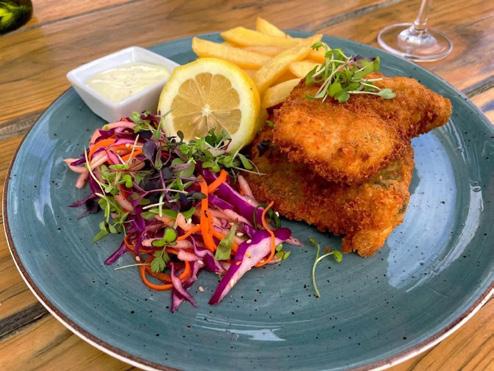
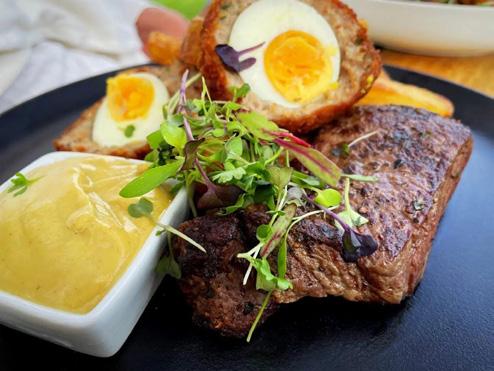
Our wood fired pizza oven has been a great addition, because after all, who doesn’t love a great pizza?! Our new kiddies lunch boxes have also proved a hit; a handy lunch box containing a choice of a cheeseburger, fish bites or chicken strips. Added to this is a fizzer, lollipop, juice and fries – all of this for only R85! Kids at Stanford Hills love being able to enjoy their lunch wherever they choose, which usually ends up being on the pirate ship.
A new initiative is our ‘Pensioners Tuesdays’ – a pensioners card gets you 10% discount on your bill at the Tasting Room. And, as always, furry friends are welcome too. The last Monday of every month sees the local walking group, ‘The Stanford Striders’, meeting up at the farm. A meander around the vineyards and flowers is followed by a delicious meal (usually a lasagne or Melan zane Parmagiano and salad), AND a glass
of wine for the special Striders price. Our reception and wine shop area has also seen some recent upgrades. We still sell our full selection of Stanford Hills estate wines at cellar door prices, as well as fresh bunches of proteas, pincushions, and fynbos. Special bouquets can be made up upon request. We have a wonderful selection of gift ideas, including our very popular leggings, so do keep us in mind when doing your Christmas shopping. Wine tasting is a great activity for your friends and family looking for some thing to do this coming festive season, and R70 allows you to try seven different wines and learn a lot in the process.
Sam’s garden of remembrance is looking beautiful and is open for members of the public to wander around, and to leave a stone in honour of a loved one lost. At the top of the garden is a path leading to a very special labyrinth. Labyrinth walking is an an cient practice used by many different faiths for spiritual centering, contemplation, and prayer. Entering the path of a labyrinth, you walk slowly while quieting your mind and focusing on a spiritual question or prayer.
Finally, our stage area is currently under ren ovation as we have a roof going up to protect
our performing artists from the elements. It’s nearing that time once again when we have our Summer Sessions at the Stanford Hills farm with a great line up of talent:
• 18 December: Springbok Nude Girls, Albert Frost and Black Cat Bones
• 21 December: GoodLuck, Will Linley, Casey Lowry and Veranda Panda
• 23 December: Jeremy Loops
• 27 December: Sunset Sweatshop
Be sure to like and follow our social media pages to be kept up to date on all the infor mation and details pertaining to happenings and events, as well as for when our ticket sales go live.
We look forward to a great season ahead. Thank you all for the support, and we can’t wait to welcome you in the months to come!
With much love from Jami, Peter and the Stanford Hills team.
www.stanfordhills.co.za Tel: +27 (0)28 341 0841

 Witer: Melissa Mc Alpine
Witer: Melissa Mc Alpine
has become a way of life in South Africa, and with no light at the end of the tunnel anytime soon, checking and keeping track of the daily loadshed ding schedule is something we’ve all sadly become accustomed to.
Whenever there is loadshedding, munici palities around South Africa receive endless complaints about generator noise coming from next door neighbours. ‘Neighbour Law’ states that a property owner is entitled to the free use and enjoyment of his property, provided he does not infringe on his neighbour’s rights. This
means that while there are no hard and fast rules in place regulating generator use in resi dential areas, there is a limit to how much noise is allowed. The responsibility falls on the owner to ensure that the noise is kept to a minimum.
• Purchase a generator that is rated suit able for residential use.
• Ensure the generator is correctly installed to keep the noise level to a minimum.
• Find a suitable location for the generator –as far away from the neighbours as possible.
• Consider sound proofing the generator with a cover or placing it in an outbuilding.
• Ensure the generator is kept well-main tained.
Instead of relying on a generator, con sider alternatives such as a battery-op erated UPS system, embedded solar generation (albeit still in its infancy), making use of a gas stove for cooking and heating up water, and battery-op erated lanterns. All of these items will ensure that you remain on good terms with your neighbours.
Before reporting the noise distur bance to your local municipality, first voice your concern with your neigh bours so that they can be made aware of the disturbance and have an oppor tunity to first sort it out themselves.
Thenew Floriligium at Grootbos with its unique collection of original watercolour paintings of fynbos and associated polli nators, has undoubtedly upped the interest in learning more about the unique floral system that flourishes on our doorstep and nowhere else on the planet.
Stanford pre-school teacher, author, and en vironmental biologist, Louisa Oberholzer, has a wonderful story about her journey with a partic ular species of fynbos that continues to survive against enormous odds, on small remaining pockets of limestone, not far from Stanford.
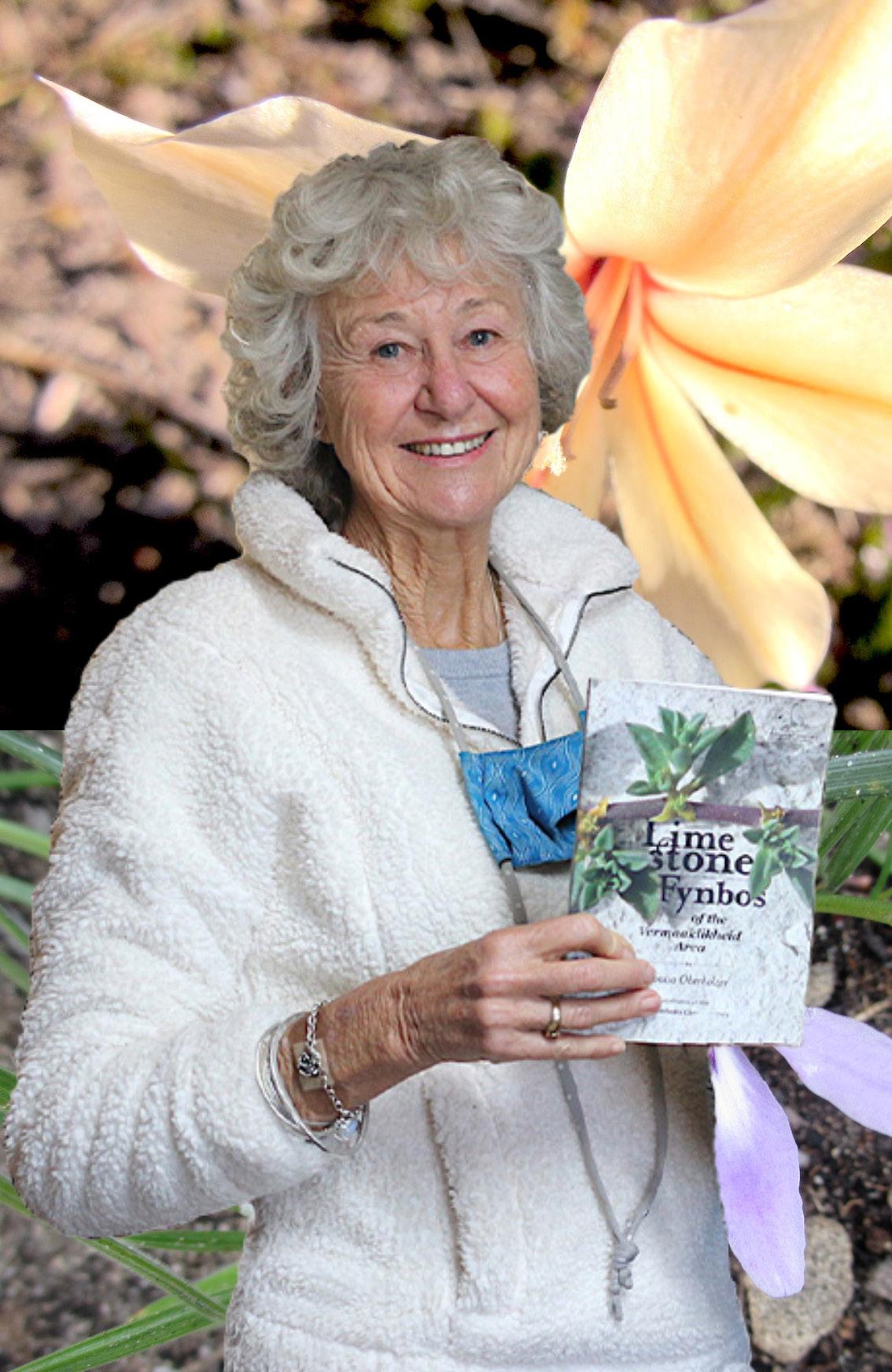
Recording and identifying these endan gered and fragile plants with their delicate, fairy like flowers that grow on limestone and nowhere else has been what she calls “a rich and incredible” journey of learning.
It all began, she recalls with the work of a Cape botanist, Barry Low, who at the time was visiting a farm that Louisa and her husband Bernard Oberholzer owned in Vermaaklikheid.
“I remember the day so well. Barry showed us a mountain of plant species that he had collected. Among them were unusual flora that needed to be recorded.”
For the record, Bernard, a landscape architect, often invited students of the landscape architec ture masters’ programme, which he ran at UCT, to the farm to study the limestone terrain.”

“That was the beginning of my mission” says Louisa. “For the next five years I gath ered, pressed, recorded and identified rare fynbos species that only grow on limestone.”
Saving limestone fynbos, probably the most ancient of all fynbos, will be a major task, she believes.
“It is hugely threatened. Saving it from extinction will require the public, and partic ularly landowners, to realise that limestone fynbos will only survive if alien vegetation which is a major threat to all the fynbos plant communities, is controlled.”
In her continuing research, Louisa has discovered species of limestone Fynbos in and around Stanford which still need to be positively identified.
The formation of this rough white rock, which can be seen on the cliffs at De Kelders created the opportunity for new fynbos species to evolve. Most fynbos plants thrive on acidic soils. Limestone formed from compressed sand dunes is alkaline, yet the Fynbos plants that evolved found a way to thrive on soils that should have been toxic to them. Louisa’s book, ‘Limestone Fynbos of the Vermaaklikheid Area’ recently reprinted is a handy guide to identify these plants and is available to purchase at Egret and the Owl Book Café in Queen Victoria Street, Stanford.
appointment, brush your pet at least once a day, removing as many mats as possible and get him or her used to having feet touched. Good preparation before the appointment will mean a better experience for both your pet and the groomer.
“Some pet owners don’t brush or groom their dogs and then expect the dog groomer to perform miracles. Regular grooming is essen tial for a dog’s health and wellbeing. They get depressed when they’re not clean and when their skin doesn’t feel nice.”
According to the National Pet Grooming Association of South Africa (NPGASA), a pro fessional grooming session typically consists of the dog being brushed, bathed, and dried, as well as trimmed or clipped with clean, sani tised brushes and clipper blades.

Summer is just about here and for most pooches, that means it’s time to get rid of the winter coat and say hello to a sleeker, cooler look.
Having said that, if you’ve ever attempted to bath and groom your dog at home, you will have realised that it isn’t always that easy.
Firstly, pets play up… because, well, they know they can. Your bathroom looks as though it has been hit by a flash flood. There will be soggy towels everywhere and if your pooch is not used to a hair dryer, the first blast of warm air will send him or her to the safety of the couch, sodden. That’s why most dog owners – if they can
afford to – would prefer making use of a pro fessional pet groomer to do the necessary.
Finding one, however, isn’t easy though. When the temperature goes up, so do the demands for pet grooming services. If you leave booking too late, you’ll find that the only available dates are three weeks or more down the line.
Advice given locally was “wait for that appointment” rather than trying to do it your self or going to somebody that hasn’t been recommended and may not have the correct equipment available.
And here’s a bit of homespun advice, also from a local groomer - while you wait for that
While the NPGASA itself does not currently offer Grooming Qualification or certifications, the members of the NPGASA have, they tell us, uniformly agreed to incorporate these standards of care, safety and sanitation into their own education, training and certification programmes.
Pricing is something you might want to enquire about upfront to avoid any unpleasant surprises later on when it comes to paying. The cost of grooming can vary by dog size and coat type, as well as what services are included in a standard bath or groom. Some dogs also take longer to groom than others. A professional groomer will often quote you a rate once they assess your dog’s individual needs. Between R260 (for a basic groom), to around R360 (for a full groom) seems to be the average price.
GARLIC & ONIONS: Onions, shallots, scallions, and garlic in all forms – powdered, raw, cooked, or dehydrated – can destroy a dog’s red blood cells, leading to anaemia. Symptoms of anaemia include weakness, vomiting, little interest in food, dullness, and breathlessness. The damage generally doesn’t become appar ent until three to five days after a dog eats one of these items.
MUSHROOMS: Mushrooms can contain toxins which may affect multiple systems in the body. Wild mushrooms — which may be found grow ing in your backyard or on outdoor trails where you walk your dog — can trigger reactions in the kidneys, liver and brain. Mushroom toxicity is known to be fatal in dogs, resulting from seizures, tremors, and organ failure.
CAFFEINE: Chocolate, coffee, or any products containing caffeine, theobromine, or theophyl line can be toxic to a dog’s heart and nervous systems. The darker the chocolate, the worse it is for your dog. Reactions can range from vom
iting, increased thirst, abdominal discomfort, and restlessness to severe agitation, muscle tremors, irregular heart rhythm, high body temperature, seizures and death.
XYLITOL: While it’s completely safe for humans, Xylitol, an artificial sweetener found in many sugar-free products, can result in a rapid, severe insulin release when ingested by dogs. Acute poisoning will occur in as little as 10 to 15 minutes, resulting in hypoglycemia (life-threateningly low blood sugar) and acute hepatic necrosis (severe liver failure).
FRUIT PITS: Pits of any kind can cause in testinal obstruction. Apple seeds and pits of cherries, peaches, pears, plums, and apricots also contain cyanide, which is poisonous to both humans and dogs. Dogs should not be allowed to chew on fruit pits, as chewing could also result in the pit being swallowed, causing continuous exposure to cyanide, or could cause the dog to choke.
GRAPES & RAISINS: Grapes and raisins have
been associated with the development of kidney failure in dogs. Death due to kidney failure may occur within three to four days after ingestion, and long-term kidney disease may persist in dogs who survive the initial intoxication.
NUTS: Most nuts are bad for dogs; macada mia nuts are the worst. Nuts have compounds that accelerate the growth of bladder stones and weaken the bones. Although the exact tox in macadamia nuts in particular is unknown, ingestion of these nuts by dogs have been associated with vomiting, muscle and joint pain, swelling, and lethargy.
AVOCADOS: Avocado leaves, pits, skin, and fruit contain a toxin called persin. Certain va rieties of avocado can cause upset stomachs, breathing difficulties, and fluid buildup in the chest. Also, the pit can accidentally be swal lowed, leading to obstruction of the gastroin testinal tract.
- Source: Alldogboots.com
Todaythere is still a lot of good news and wonderful actions that are happening all around us. Although they do not appear in the media, they are changing the planet and humanity while social networks are full of hate and negativity. I want to help dissolve the darkness with more pleasant and joyful news and facts, and to say that our world is not so bad:
• The Norwegians have decided not to drill oil wells in the Lofoten Islands (with 53 mil lion dollars in oil reserves), so to preserve the ecosystem of the islands.
• For the first time in Malawi’s history, a woman has been elected Speaker of the country’s parliament. Esther Challenge has cancelled more than 1,500 underage mar riages and sent the children back to school.
• Swedish donors receive a thank you text every time their blood saves lives.
• Thanks to the Endangered Species Law, the population of sea turtles almost in danger of extinction has increased by 980%.
• Thai supermarkets have stopped using
plastic bags and are now wrapping their purchases in banana leaves.
• Holland is the first country that doesn’t have any stray dogs.
• South Korea organises dance parties for people over 65 to fight dementia and loneliness.
• In Rome, you can pay for a ticket on the metro using plastic bottles. As a result, 350,000 bottles have already been collect ed.
• California restricts the sale of dogs, cats and rabbits in stores to encourage people to adopt pets from shelters.
• Rice farmers around the world are starting to use ducks in their fields instead of making use of harmful pesticides. Ducks eat insects and peck out the weeds without touching the rice.

• Canada enacted a law that prohibits the use of dolphins in the entertainment industry.
• The Netherlands plants the roofs of hun dreds of bus stops with flowers and plants specifically to feed bees.
• Iceland became the first country in the world to legalise equal pay for men and women.
• German circuses use holograms instead of real animals to stop the exploitation of animals in circuses.
• The LarvalBot underwater robot sows the bot tom of the Great Barrier Reef with microscopic corals grown specifically for the restoration of the em endangered by sea pollution.
• To reduce the number of suicides, Sweden have arranged the world’s first psychiatric ambulance.
• An Indian village celebrates the birth of each girl by planting 111 trees. To date, 350,000 trees have already been planted.
• Thanks to the ban on hunting humpback whales, their population has grown from several hundred to more than 25,000.
• The Netherlands has built five artificial islands specifically for the conservation of birds and plants. Two years later, there are already 30,000 birds living there, and 127 species of plants are growing.
What if instead of always dwelling on the negative, we share the good news happening instead… It will be a better way to coun teract evil with good and to promote calm, and healthy habits, as well as good deeds in today’s world.
